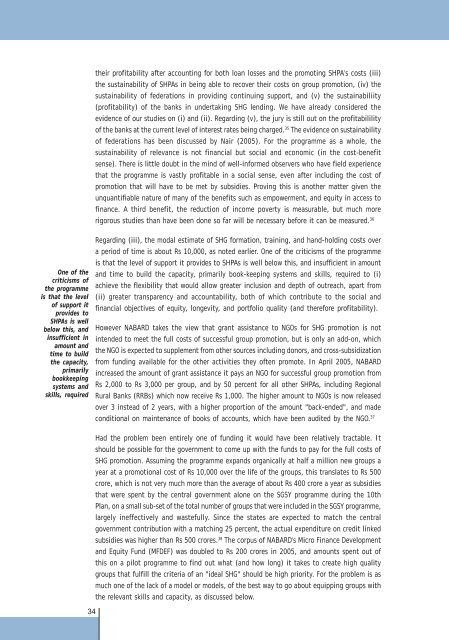Download sector_report1.pdf - Microfinance and Development ...
Download sector_report1.pdf - Microfinance and Development ...
Download sector_report1.pdf - Microfinance and Development ...
You also want an ePaper? Increase the reach of your titles
YUMPU automatically turns print PDFs into web optimized ePapers that Google loves.
their profitability after accounting for both loan losses <strong>and</strong> the promoting SHPA's costs (iii)<br />
the sustainability of SHPAs in being able to recover their costs on group promotion, (iv) the<br />
sustainability of federations in providing continuing support, <strong>and</strong> (v) the sustainabiliity<br />
(profitability) of the banks in undertaking SHG lending. We have already considered the<br />
evidence of our studies on (i) <strong>and</strong> (ii). Regarding (v), the jury is still out on the profitabilility<br />
of the banks at the current level of interest rates being charged. 35 The evidence on sustainability<br />
of federations has been discussed by Nair (2005). For the programme as a whole, the<br />
sustainability of relevance is not financial but social <strong>and</strong> economic (in the cost-benefit<br />
sense). There is little doubt in the mind of well-informed observers who have field experience<br />
that the programme is vastly profitable in a social sense, even after including the cost of<br />
promotion that will have to be met by subsidies. Proving this is another matter given the<br />
unquantifiable nature of many of the benefits such as empowerment, <strong>and</strong> equity in access to<br />
finance. A third benefit, the reduction of income poverty is measurable, but much more<br />
rigorous studies than have been done so far will be necessary before it can be measured. 36<br />
One of the<br />
criticisms of<br />
the programme<br />
is that the level<br />
of support it<br />
provides to<br />
SHPAs is well<br />
below this, <strong>and</strong><br />
insufficient in<br />
amount <strong>and</strong><br />
time to build<br />
the capacity,<br />
primarily<br />
bookkeeping<br />
systems <strong>and</strong><br />
skills, required<br />
Regarding (iii), the modal estimate of SHG formation, training, <strong>and</strong> h<strong>and</strong>-holding costs over<br />
a period of time is about Rs 10,000, as noted earlier. One of the criticisms of the programme<br />
is that the level of support it provides to SHPAs is well below this, <strong>and</strong> insufficient in amount<br />
<strong>and</strong> time to build the capacity, primarily book-keeping systems <strong>and</strong> skills, required to (i)<br />
achieve the flexibility that would allow greater inclusion <strong>and</strong> depth of outreach, apart from<br />
(ii) greater transparency <strong>and</strong> accountability, both of which contribute to the social <strong>and</strong><br />
financial objectives of equity, longevity, <strong>and</strong> portfolio quality (<strong>and</strong> therefore profitability).<br />
However NABARD takes the view that grant assistance to NGOs for SHG promotion is not<br />
intended to meet the full costs of successful group promotion, but is only an add-on, which<br />
the NGO is expected to supplement from other sources including donors, <strong>and</strong> cross-subsidization<br />
from funding available for the other activities they often promote. In April 2005, NABARD<br />
increased the amount of grant assistance it pays an NGO for successful group promotion from<br />
Rs 2,000 to Rs 3,000 per group, <strong>and</strong> by 50 percent for all other SHPAs, including Regional<br />
Rural Banks (RRBs) which now receive Rs 1,000. The higher amount to NGOs is now released<br />
over 3 instead of 2 years, with a higher proportion of the amount "back-ended", <strong>and</strong> made<br />
conditional on maintenance of books of accounts, which have been audited by the NGO. 37<br />
Had the problem been entirely one of funding it would have been relatively tractable. It<br />
should be possible for the government to come up with the funds to pay for the full costs of<br />
SHG promotion. Assuming the programme exp<strong>and</strong>s organically at half a million new groups a<br />
year at a promotional cost of Rs 10,000 over the life of the groups, this translates to Rs 500<br />
crore, which is not very much more than the average of about Rs 400 crore a year as subsidies<br />
that were spent by the central government alone on the SGSY programme during the 10th<br />
Plan, on a small sub-set of the total number of groups that were included in the SGSY programme,<br />
largely ineffectively <strong>and</strong> wastefully. Since the states are expected to match the central<br />
government contribution with a matching 25 percent, the actual expenditure on credit linked<br />
subsidies was higher than Rs 500 crores. 38 The corpus of NABARD's Micro Finance <strong>Development</strong><br />
<strong>and</strong> Equity Fund (MFDEF) was doubled to Rs 200 crores in 2005, <strong>and</strong> amounts spent out of<br />
this on a pilot programme to find out what (<strong>and</strong> how long) it takes to create high quality<br />
groups that fulfill the criteria of an "ideal SHG" should be high priority. For the problem is as<br />
much one of the lack of a model or models, of the best way to go about equipping groups with<br />
the relevant skills <strong>and</strong> capacity, as discussed below.<br />
34














